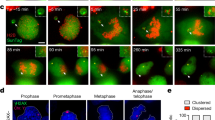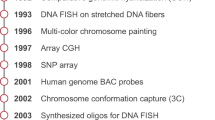Abstract.
We have investigated the origin and nature of chromosome spatial order in human cells by analyzing and comparing chromosome distribution patterns of normal cells with cells showing specific chromosome numerical anomalies known to arise early in development. Results show that all chromosomes in normal diploid cells, triploid cells and in cells exhibiting nondisjunction trisomy 21 are incorporated into a single, radial array (rosette) throughout mitosis. Analysis of cells using fluorescence in situ hybridization, digital imaging and computer-assisted image analysis suggests that chromosomes within rosettes are segregated into tandemly linked “haploid sets” containing 23 chromosomes each. In cells exhibiting nondisjunction trisomy 21, the distribution of chromosome 21 homologs in rosettes was such that two of the three homologs were closely juxtaposed, a pattern consistent with our current understanding of the mechanism of chromosomal nondisjunction. Rosettes of cells derived from triploid individuals contained chromosomes segregated into three, tandemly linked haploid sets in which chromosome spatial order was preserved, but with chromosome positional order in one haploid set inverted with respect to the other two sets. The spatial separation of homologs in triploid cells was chromosome specific, providing evidence that chromosomes occupy preferred positions within the haploid sets. Since both triploidy and nondisjunction trisomy 21 are chromosome numerical anomalies that arise extremely early in development (e.g., during meiosis or during the first few mitoses), our results support the idea that normal and abnormal chromosome distribution patterns in mitotic human cells are established early in development, and are propagated faithfully by mitosis throughout development and into adult life. Furthermore, our observations suggest that segregation of chromosome homologs into two haploid sets in normal diploid cells is a remnant of fertilization and, in normal diploid cells, reflects segregation of maternal and paternal chromosomes.
Similar content being viewed by others
Author information
Authors and Affiliations
Additional information
Received: 19 January 1998; in revised form: 28 May 1998 / Accepted: 30 June 1998
Rights and permissions
About this article
Cite this article
Nagele, R., Freeman, T., Fazekas, J. et al. Chromosome spatial order in human cells: evidence for early origin and faithful propagation. Chromosoma 107, 330–338 (1998). https://doi.org/10.1007/s004120050315
Issue Date:
DOI: https://doi.org/10.1007/s004120050315




